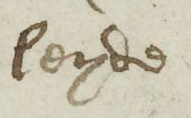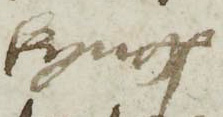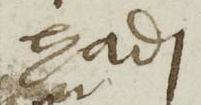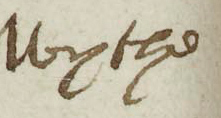|
| A |
 | Usage: all
single compartment 'a' used throughout. The down-stroke is usually set at a slant from the main compartment. |  | Usage: was
there is little variation in the formation of 'a'. |
 | Usage: attyred |  | Usage: passed |
|
| D |
 | Usage: dede
looped 'd' used throughout. Generally, the lobe is small and the loop tall but rounded. |  | Usage: had
final looped 'd' with long, straight downward tag to finish. 'd' is frequently tagged in this position. |
 | Usage: to gedders
'd' is quite upright and similarly formed in every situation. |  | Usage: leyde
'd' with continuous stroke to oin with final 'e'. |
|
| G |
 | Usage: good
tailed 'g' with oval compartment and a thick, sweeping and tapering tail. |  | Usage: wysytyng
'g' in final position with extended horizontal stroke through the head. |
 | Usage: Iugge
the second 'g' in this combination appears horned because of the horizontal joining stroke running from the first 'g' through to final 'e'. |  | Usage: kyng(es)
'g' in final position with attached symbol for the 'es' plural tag. |
|
| H |
 | Usage: had
a typical 'h' with looped head leading to a curved stem, angled shoulder and a parallel counter-clockwise return. |  | Usage: folowythe |
 | Usage: theym
the cross-bar from 't' leads in to the head-stroke of 'h'. This time the tail-stroke turns sharply clockwise, crossing the shoulder stroke to begin the following 'e'. |  | Usage: myght
the 'ght' combination. |
|
| R |
 | Usage: notaryes
long 'r' is used most of the time in every position except after 'o' and some round-bodied graphs. |  | Usage: flatterer
long 'r' in final position with fork below the level of other long graphs and a wide opening leading to a small curve downwards at the shoulder. |
 | Usage: forth
'z'-shaped 'r' after 'o' and also some round-bodied graphs. |  | Usage: freres |
|
| S |
 | Usage: somoners
long 's' is used in initial and medial positions. |  | Usage: lyers
6-shaped 's' always used in final position. |
 | Usage: passed |  | Usage: shall
long 's' in combination with 'h'. |
|
| W |
 | Usage: was
the left limb of 'w' is upright. Sometimes there is a lead-in stroke to begin. |  | Usage: draw
'w' in final position. |
 | Usage: wt
the scribe frequently uses this abbreviated form of 'with'. |  | Usage: westmy(n)ster
the scribe does not use upper case letters on this folio. His power case 'w' is probably exactly the same as his upper case one. |
|
| Y |
 | Usage: yff
a lead-in stroke to the curved left limb stroke. The tail turns counter-clockwise. |  | Usage: palfrey
the tail of 'y' is straight with no return. |
 | Usage: wysytyng
a wonderful spelling for 'visiting'. A collection of 'y's with a variety of shapes, all in the same word. |  | Usage: shyre
a 'y' with shallow 'v'-shaped body set at the level of the shoulder of the preceding 'h'. |


































